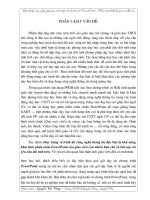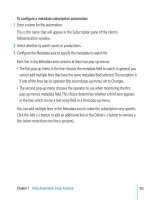9 5đ final proposal
Bạn đang xem bản rút gọn của tài liệu. Xem và tải ngay bản đầy đủ của tài liệu tại đây (277.76 KB, 12 trang )
1
Table of contents
1. Rationale …………………………………………………………………..3
1.1. Problem statement ……………………………………………………..3
1.2. Research objectives ……………………………………………………3
1.3. Research questions …………………………………………………….3
2. Literature Review ………………………………………………………...3
2.1. What is green cosmetics?........................................................................3
2.2. What is the purchase intention of buying products? …………………..3
2.3. Factors affect the purchase intention of customers ……………………4
3. Theoretical Framework …………………………………………………..4
4. Hypothesis Development…………………………………………………..5
4.1. The relationship between the level of knowledge about green cosmetics
and purchase intention ………………………………………………...5
4.2. The relationship between the social factors about green cosmetics
and purchase intention………………………………………………... 5
4.3. The relationship between product availability of green cosmetics
and purchase intention ………………………………………………...5
4.4. Self-efficacy affects their intention to purchase green cosmetics into
actual behavior………………………………………………………... 6
5. Research methodology……………………………………………………..7
5.1. Research Design………………………………………………………..7
5.2. Population and Sample ………………………………………………...7
5.3. Data collection methods ……………………………………………….8
6. Research Report Structure ……………………………………………….10
7. Time Frame ………………………………………………………………..10
References …………………………………………………………………13
2
1. Rationale:
1.1. Problem statement:
Cosmetics is a dispensable part of every woman's daily lives. Nowadays, people are
more worried about their health and environmental issues, so green cosmetics have
appeared to meet the needs of women and gained a lot of attention from Vietnam
consumers due to its great safety and environmental friendliness. Consumers are more
aware of the negative consequences of cosmetic items loaded with inorganic material
because using personal care products is a common practice. Young female consumers,
especially educated working women, are highly motivated to use chemical-free
cosmetics since they help protect human skin while having little to no negative
environmental consequences.
1.2. Research objectives:
We wish to conduct this research to: (1) Identify the factors that affect purchase
intention of female shoppers towards green cosmetics, (2) Boost the organic industry
by giving a greater grasp of consumers' behavior when in the segment of green
cosmetics, (3) Give a hand for green cosmetics products producers and retailers to
acquire a comprehension of significant values that can influence consumers' attitudes
toward purchasing intentions for these products.
1.3. Research questions
This research is designed to answer the following questions:
- What factors influence purchase intention of females towards greener and safer
products?
- How has the buying intention of ladies changed from the past to recently?
- How can women know more about green cosmetics?
2. Literature review
2.1. What is green cosmetics?
Green cosmetics, also called natural and organic cosmetics, consist of natural
resources, such as fruit-based ingredients without chemicals, additives, or any non
natural mixtures; they aim to preserve the environment and the welfare of animal
species. In other words, green cosmetics are produced without pesticides, synthetic
chemicals, or animal testing. Green cosmetics include a wide range of personal care
products, including environmentally friendly creams, makeup, and beauty products.
2.2. What is the buyers’ purchase intention?
Purchase intention refers to the need and decision-making processes that consumers go
through when purchasing a product or service. It involves the psychological, social,
and economic factors that influence consumer choices. On the other hand, it is the
likelihood or inclination of a consumer to buy a particular product or service.
3
2.3. Factors affect the purchase intention of customers:
Buyer's purchase intention is influenced by various factors, including:
● Personal Factors: These include the consumer's age, gender, occupation,
lifestyle, personality, and individual preferences.
● Psychological Factors: Psychological factors play a significant role in buyer's
behavior. These factors include perception, motivation, learning, beliefs,
attitudes, and emotions.
● Social Factors: Social factors encompass the influence of family, friends, social
groups, culture, and society on consumer behavior. These factors shape
consumers' preferences, opinions, and buying decisions.
● Economic Factors: Economic factors, such as income level, disposable income,
savings, and economic conditions, influence consumers' purchasing power and
their willingness to spend.
● Brand image, perceived quality, perceived price and perceived value.
● Decision-Making Process: Consumers typically go through a decision-making
process when making a purchase. This process includes problem recognition,
information search, evaluation of alternatives, purchase decision, and
post-purchase evaluation.
3. Theoretical framework:
In our study, we choose the Information-Motivation-Behavioral Skills (IMB) model.
The model includes three key factors: information and knowledge about the behavior,
individual motivation (including personal attitudes) and subjective norms (social
influence), and behavioral skills such as self-efficacy. We suppose that green cosmetics
purchase intention is affected by the knowledge and attitude toward green cosmetics as
well as by the interaction between them. These relationships are moderated by
self-efficacy. The following figure represents the theoretical framework:
4
We want to examine the direct effects of green cosmetics knowledge, attitude toward
purchasing green cosmetics, and subjective norms on the intention to buy green
cosmetics. Additionally, we wish to explore the indirect effects of these factors through
self-efficacy. By applying the IMB framework, we aim to understand how these factors
influence the purchase intention of women towards green cosmetics.
4. Hypothesis development:
4.1. The relationship between the level of knowledge about green cosmetics and
purchase intention:
A good level of knowledge about cosmetics and a green lifestyle positively influences
purchase intentions for green cosmetics in Vietnam by empowering consumers to make
informed choices, prioritize sustainability, and support brands that align with their
values.
Knowledge about green cosmetics helps consumers in Vietnam comprehend the
benefits and features of these products. They become aware of the harmful effects of
conventional cosmetics and the advantages of choosing environmentally friendly
alternatives. With this knowledge, consumers in Vietnam can actively seek out
cosmetics with natural, organic, and eco-friendly ingredients.
Green lifestyle knowledge inspires consumers to prioritize sustainability and
environmental conservation. They understand the negative impact of conventional
cosmetics on the environment, such as pollution, deforestation, and animal testing.
Armed with this knowledge, consumers in Vietnam are motivated to support brands
that offer green cosmetics. Consumers in Vietnam who are well-informed about these
topics are more likely to research and seek out brands that are transparent, ethical, and
committed to sustainability.
H1: The level of knowledge about cosmetics and green lifestyle has a positive impact
on purchase intention green cosmetics in Vietnam.
4.2. The relationship between the social factors about green cosmetics and
purchase intention:
Social norms and values: The social norms and values surrounding green and
sustainable consumption may impact female shoppers' purchase intention. If green
cosmetics are considered fashionable and following the social rules, it may positively
influence purchase intention.
Peer influence: The influence of friends, family, or social networks may play a role in
shaping female shoppers' purchase intention towards green cosmetics. Positive
recommendations or social pressure from peers may increase purchase intention.
H2: The social factors about cosmetics and green lifestyle have a positive impact on
purchase intention of green cosmetics in Vietnam.
5
4.3. The relationship between product availability of green cosmetics and
purchase intention:
Product availability significantly impacts the intention to buy green cosmetics in
Vietnam by providing convenience, increasing awareness and discovery, enabling trial
and experience, building trust, and facilitating word-of-mouth recommendations.
Convenience: The availability of green cosmetics in easily accessible locations, such as
local stores or online platforms, increases convenience for buyers in Vietnam. When
consumers can easily find and purchase green cosmetics without much effort or
inconvenience, it enhances their intention to buy these products.
When green cosmetics are readily available in various retail outlets, it increases the
chances of consumers in Vietnam coming across these products and becoming aware of
their existence. Greater visibility and availability of green cosmetics create
opportunities for consumers to explore and discover new brands and products.
Availability allows consumers in Vietnam to physically interact with green cosmetics,
such as testing samples or receiving expert advice in-store. This hands-on experience
helps them assess the quality, texture, scent, and effectiveness of the products.
When consumers find green cosmetics consistently available at reputable and
well-known retailers or online platforms, it enhances their trust and confidence in the
products. The presence of green cosmetics in established stores or platforms implies
that they have undergone certain quality checks and meet specific standards.
H3: Product availability positively impacts the intention to buy green cosmetics in
Vietnam.
4.4. Self-efficacy affects their intention to purchase green cosmetics into actual
behavior.
In the context of green cosmetics purchase intention, self-efficacy can play a role as a
mediator in the relationship between certain factors and the intention to purchase green
cosmetics.
When self-efficacy mediates the relationship with green cosmetics purchase intention,
it means that the level of self-efficacy a person has regarding their ability to make
environmentally friendly choices influences their intention to purchase green
cosmetics.
Therefore, while self-efficacy can mediate the relationship between certain factors and
green cosmetics purchase intention, it is important to consider these other factors as
well for a comprehensive understanding of consumer behavior in this domain. Hence,
we advance the following hypotheses:
H4: Self-efficacy can influence the translation of knowledge into action, with
individuals who have higher self-efficacy being more likely to turn their intention to
purchase green cosmetics into actual behavior.
6
H5: Self-efficacy affects how attitudes translate into behavior, with individuals who
have higher self-efficacy being more likely to turn their positive attitudes into actual
purchase buying green cosmetics.
H6: Self-efficacy mediates the positive relationship between subjective norms and
green cosmetics purchase intention.
5. Research methodology:
5.1. Research Design:
Purpose of the study:
This research is a causal study. We aim to gather information and develop hypotheses
on the factors of female shoppers' purchasing decisions toward green cosmetics in
Hanoi. In our case, we investigate the relationships between factors of green cosmetics
and women's purchase intention. So we can offer specific solutions to increase
women’s consumption with green cosmetics.
Extent of researcher interference:
The extent of research interference is minimal in this study, because the study
investigates factors affecting buying behavior and purchase intention of female
shoppers towards green cosmetics based on existing facts, recorded statistics and
recorded studies on the subject.
Study setting:
The study is non-contrived. The study can be done in a natural environment without
artificial interference.
Research strategies:
In this study, we believe the causal study and survey research method would be the best
method of approach. Survey research focuses on gathering basic to in-depth
information of the interviewee, providing the necessary data for statistics and
classification. Then apply to the specific research topic and it is perfect to generalize
results from a larger sample population.
Unit of analysis:
Due to the nature of our research being rather concise, we selected the individuals as a
unit of analysis.
5.2. Population and Sample:
The target population:
The target population of this research proposal is female shoppers in Hanoi who
purchase cosmetics. The study will focus on their purchasing decisions toward green
cosmetics, which are products that are environmentally friendly, organic, or natural.
7
The target population will be selected based on the following criteria: Age (18 to 65
years old), location (Ha Noi city) with shopping behavior (purchased cosmetics at least
once in the past six months) and being aware of the concept of green cosmetics or
willing to learn more about it. The target population will be estimated using census
data, market reports, and online surveys.
The sample:
The questionnaires of this research proposal will be distributed to 500 female shoppers
in Hanoi who had bought cosmetics in the past. We estimated sample size using the
Raosoft Sample Size Calculator, a widely used online sample calculator, which is
recommended to determine the sample size taking into consideration the population
size. Based on a power analysis with a 95% confidence level, a 5% margin of error, a
sample size of at least 385 respondents was required. The sampling method will be
stratified random sampling, which will ensure that the sample is representative of the
target population in terms of age, income, and education. Online and offline surveys
that were self-administered were used to gather the data. The majority of the
distribution locations for the onsite survey were public spaces such as coffee houses,
workplaces, malls, and sports facilities. Data was gathered for the online survey
through a web-based questionnaire created in Google Docs and shared in Facebook
groups for young people or with the researchers' personal contacts. Multiple
personalized reminder messages were sent to all non-respondents.
5.3. Data collection methods:
Questionnaires were distributed to 500 individuals. A total of 411 responses were
received, with a high response rate of 82.2%. The majority of them (65%) participated
online. After removing the incomplete and unusable surveys, the remaining 393
samples were used for further analysis.
The questionnaire design for the study would include 4 parts:
● Part 1: Demographic questions asking the respondents to give the general
information of their genders, ages, occupations and marital status (4 questions).
● Part 2: Their experience in trying and preferences in the usage of green
cosmetics: they would prefer using typical cosmetics or green cosmetics (2
questions).
● Part 3: Access to green cosmetic products and different brands’ marketing
strategy, asking which brands they have ever heard about (2 questions).
● Part 4: Using scale questions to measure factors affecting green cosmetics’
buying behavior and purchase intention of female shoppers (measure factors
through 12 questions).
8
Numbers
Variables
Items
Sources
1
Knowledge
●
2
General attitude
●
3
Subjective norms ● Most people important to
me would prefer that I use
green cosmetics
● My family members think
that I should use green
cosmetics
● My friends think that I
should use green cosmetics
Yazdanpanah et
al. (2015) and
Ajzen et al.
(1991).
4
Self- efficacy
Ajzen et al.
(1991) and
Sotiropoulos et
al. (2013).
I know what green cosmetics Ajzen et al.
are
(1991) and Wang
et al. (2019).
● I am familiar with the term
“green cosmetics’’
● I can easily distinguish green
cosmetics from other
cosmetics
For me, buying green
cosmetics is a smart
decision
● I like the idea of purchasing
green products
● I feel proud to buy green
cosmetics
I can decide whether to
purchase green cosmetic
products or not by myself
● I can make the decision to
purchase green cosmetic
products
● I believe that I have the
resources and ability to buy
green cosmetics
●
Ajzen et al.
(1991) and
Prakash et al.
(2019).
9
6. Research Report Structure
● Title
● Table of contents
● Abstract
- Background & Objectives
- Research methods
- Results
- Conclusions
● Introduction
- Research background
- Problem statement
- Research objectives
- Aim of the study
- Research questions
● Literature review
- Literature review
- Proposed theoretical framework
- Hypothesis
● Research Methods
- Research design
- Sampling methods
- Instrumentation
● Data analysis & Interpretation
- Demographic Profile of the Respondents
- Analysis
● Result & Discussion.
7. Time frame:
18/08/2023 - 18/09/2023: Review literature and develop instrumentation
19/09/2023 - 19/10/2023: Finalize the instrumentation
Collect primary data
20/10/2023 - 20/11/2023: Processed collected data
21/11/2023 - 21/12/2023: Writing report
10
References:
McEachern, M.G.; McClean, P. (2002) Organic purchasing motivations and attitudes:
Are they ethical?. International Journal of Consumers Study, 26(2), 85-92. Retrieved
from:
/>_and_attitudes_Are_they_ethical
Shimul, A.S.; Cheah, I.; Khan, B.B. (2022). Investigating female shoppers’ attitude and
purchase intention toward green cosmetics in South Africa. Journal of Global
Marketing, 35(1), 37-56. Retrieved from:
/>_Attitude_and_Purchase_Intention_toward_Green_Cosmetics_in_South_Africa
Limbu; Pham,L. ; Nguyen,T. (2022). Predictors of Green Cosmetics Purchase
Intentions among Young Female Consumers in Vietnam. Sustainability. 14(19), 12599.
Retrieved from:
/>T2S3d26KhrutYY0Yqab9GY7TLxI8S6rH69ZWE
Raosoft, Inc. Raosoft Sample Size Calculator. (2004). Available online:
/>Ajzen, I. (1991). The theory of planned behavior. Organizational Behavior and Human
Decision Processes. 50, 179–211. Retrieved from:
/>Yazdanpanah, M.; Forouzani, M.(2015). Application of the theory of planned behavior
to predict Iranian students’ intention to purchase organic food. Journal of Cleaner
Production. 107, 342–352. Retrieved from:
/>Wang, X.; Pacho, F.; Liu, J.; Kajungiro, R.(2019). Factors influencing organic food
purchase intention in developing countries and the moderating role of knowledge.
Sustainability, 11, 209. Retrieved from:
/>Kim, H.Y.; Chung, J.(2011). Consumer purchase intention for organic personal care
products. Journal of Consumer Marketing, 28, 40–47. Retrieved from:
/>ullSc=1
Prakash, G.; Choudhary, S.; Kumar, A.; Garza-Reyes, J.A.; Khan, S.A.R.; Panda, T.K.
(2019). Do Altruistic and egoistic values influence consumers’ attitudes and purchase
intentions towards eco-friendly packaged products? An empirical investigation.
Journal of Retailing and Customer Services, 50, 163–169. Retrieved from:
/>
11
Sotiropoulos, V.; d’Astous, A.(2013). Attitudinal, self-efficacy, and social norms
determinants of young consumers’ propensity to overspend on credit cards. Journal of
Consumer Policy, 36, 179–196. Retrieved from:
/>Le.L (2022). A Study on Green Cosmetic Product Purchase Intention Among
Vietnamese Consumers: Theory of Planned Behavior Perspective. Retrieved from:
/>6366&diss=y&loginDisplay=true&pq-origsite=gscholar
12









